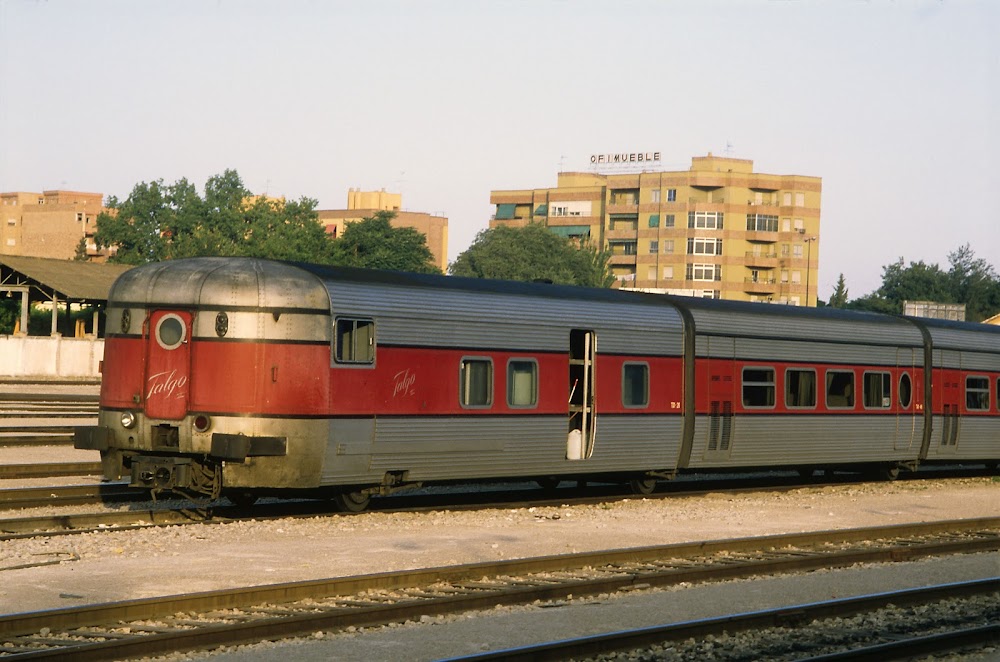I only noticed it had gone when booking some tickets. As Treneando notes, it disappeared amid official indifference, despite its official debut on May 31 1969 having been a key moment in the integration of Barcelona into the rest of Europe. The Talgo III RD was a variant on the 1964 Talgo III whose automatic variable gauge axles bridged the 233mm separating the French and the Spanish systems and made cross-border trains possible. The first trains made their way up the coast and across Provence to Geneva, which seems perhaps a curious destination until–says a passing accountant–you recall the increase in scale and sophistication required by money-launderers following the 1960s boom. Latterly the Catalán-Talgo’s quiet forays from the Estación de Francia only extended as far as Montpellier, other channels presumably having opened up in the meantime, but this site dedicated to the train helps recall its glory and here’s video of the official delegation in 1969:
https://www.youtube.com/watch?v=IuUvr2PpjxQ
I believe there are still a couple of Talgo IIIs in operation on the north coast, but visiting such a train in a museum isn’t quite the same. On my first post-natal trip to Spain, in about 1990, I arrived–wild-eyed and extremely hairy–in the middle of the night on some awful French train to Hendaye-Irún, where I was finally allowed to cross to the marvellous space canister waiting to take me to Madrid. Not having read the manual, I literally fell into the carriage: wheels were placed between carriages instead of under them, which low-slungedness made for an experience somewhere between MG and Barbarella as we drank and snacked our way at 100mph through the lunar deserts of northern Castile. Several weeks later, having been drugged and robbed of most of my worldly wealth by whores in Casablanca’s harbour, I still managed to scrape together sufficient reserves to take the return all the way from Madrid to Paris. That journey, by night, was spent consuming vodka in the bar with a delicious model at what seemed like the height of romance.
Later Talgo units (for example, those used on the stunning but still rather humdrum Barcelona-Madrid AVE) may have adopted the luxury, aerodynamic, cattle-truck look common to European railways, but the company also produced some of the most remarkable trains around in the mid- to late-20th century. This 1949 LIFE feature on the collaboration with ACF for the American market projected a serious image of the country quite distinct from the customary “Spain is different“, anti-industrial fantasies of Hemingway and atavists within the regime. (From the link: “Our men–intelligent, simple, cordial–are easier to understand for an intelligent, cordial man than for he who is in a hurry, twisted, incomplete, than for machine man, than for production line man.”) And the Talgo I “whale” was an hallucinogenic monster–see this German page for a representative selection of images and some technical data for the whole historical range.
That the man responsible for this revolution, Alejandro Goicoechea, and his financier, José Luis de Oriol (Talgo = Tren Articulado Ligero Goicoechea Oriol), remain so little known strikes me as curious. Revenge for Goicoechea having built and then betrayed Bilbao’s Cinturón de Hierro during the war, or just a continuing lack of interest in engineering?
Similar posts
- More iconoclasm in the Catalan pre-Pyrenees
Re yesterday’s post on the Santa Majestat in Caldes de Montbui, here’s some anti-Catholic propaganda from the time of George Borrow, - Referendums on independence are for pussies
Serious separatists will drive on the left, in Vic, starting Sunday. - Catalan language policy: Marxist, Stalinist, Francoist or fascist?
The precedents for, and some possible implications of, the Catalanisation of Barcelona’s cinemas. Plus some crowd-pleasing video of the Quebec language - Galdós and those spud-crazy guiris
Where did he get that - Saint George and the Catalan marionette
Let’s have a Tozer
 http://www.gnu.org/copyleft/fdl.html
http://www.gnu.org/copyleft/fdl.html
And the all stainless steel bar car. The stainless steel loos. All wonderful.
They were indeed gorgeous … but I’m wondering now whether it wasn’t all aluminium alloy. The Talgo carriage superstructure was so incredibly light because aluminium and what I guess were revolutionary construction techniques were used to replace steel, so having bet on this I’d be surprised if they swapped to steel for the interior design. I hope the aluminium wasn’t the reason why the Chinchilla accident burnt so fast – for me, especially after the incredible boredom of British train design, the Talgo III was modernism as it should be.
Re the non-visibility of Goicoechea and engineers in general: is this why (afaik) there are no (good) Talgo novels?
I think the new version of the Talgo is the Alvia.
If it’s not a donkey and cart, why should I care?
I can’t actually tell the difference between the Alvia and whatever carriages they plug into the AVE, and I hardly drink at all now.